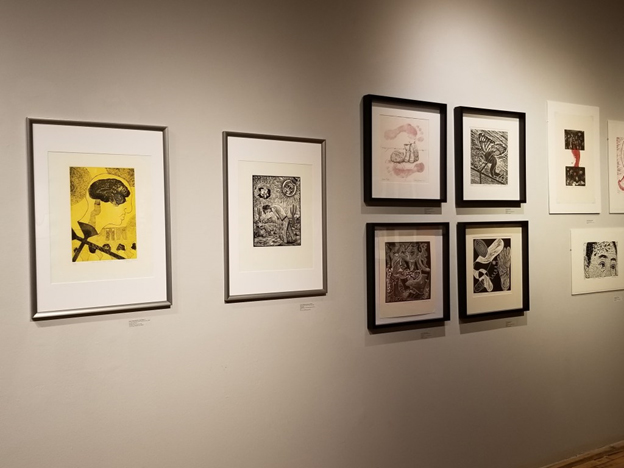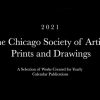

The Arceo Press has published thirteen collaborative portfolios since 2003, almost all featuring work of Mexican or Mexican-American artists. Most relate to Mexican history or folklore. No theme specifically addresses the Mexican-American border, but politically, they all can do so. As text in one of the prints asserts, “Before you came from wherever you came, these lands belonged to my ancestors.” And so this retrospective is called: “The Border Crossed Us.”
Mostly you’ll see that intensity of craftsmanship evident when lines have been carved rather than brushed or rubbed. You can feel the pressure and focus every time a sharp knife touched a soft linoleum block. The thin, elegant black lines of Carlos Barberena and Ramiro Rodriguez stand out in this regard.
Some of the content feels too personal to be social commentary or propaganda, but even these pieces feel like political cartoons. The portfolio of 2013 honored the centennial of José Guadalupe Posada (1852-1913), and here his legacy is alive and well. The messages are up-front and satirical. Complex issues are made simple, obvious and darkly humorous. It’s the voice of the honest common man or woman talking back to the corrupt people in power. Presumably it won’t stop until the border is marked by nothing more than a road sign.
This is work that depends on strong, vibrant figure drawing—accurate but not photographic, expressive but not idiosyncratic, meaningful but not solely symbolic. It attends to the inner life of the figure rather than details of its outer appearance. As Amy Diaz Infante put it, drawing “helps to slow us down, and to really LOOK at the world around us rather than relying on the symbols stored in our head—this kind of slow and deliberate attention can…help us notice the feelings, needs, dynamics and humanity of others around us.” Some of my favorite figure drawing in this show comes from the self-taught Mexican artist Juan Pablo Luna.
Validation of authenticity comes from Mexican folklore rather than contemporary art theory, so not surprisingly, there are many skulls and animated skeletons, common motifs in indigenous Mexican art. They are especially joyous and prolific in the prints of Nicolas De Jesus—convincing me that we will all have much more fun after we’re dead.
My other favorite artist in the show, Oscar Moya, is more focused on the border. That’s where he lives and that’s what he dreams about. Most of the prints in this show have the transcendent earthiness that distinguishes Mexican art. His feel the most real.
There are several good pieces in this show, and it’s exciting to see art that addresses some community other than the art world. The Arceo Press has set a high standard for visuality. But must this community always be defined by the politics of immigration? (Most of these prints were made before the election of the forty-fifth U.S. president.) Must the present always be addressed with the rhetoric of the Mexican Revolution? When will it be time to look forward with hope to where it wants to go, instead of back with anger to where it came from? (Chris Miller)
Download PDF
“The Border Crossed Us” is on view at the Bridgeport Art Center, 1200 West 35th Street, through September 6.




